CottonXL模型模拟研究延迟型低温冷害对棉花纤维品质的影响
2019-12-19王雪姣吉春容江远安杨明凤
王 森,王雪姣,吉春容,江远安,杨明凤,季 芬
CottonXL模型模拟研究延迟型低温冷害对棉花纤维品质的影响
王 森1,2,王雪姣1,2※,吉春容2,江远安2,杨明凤3,季 芬3
(1. 中国气象局乌鲁木齐沙漠气象研究所,乌鲁木齐 830002; 2. 新疆农业气象台,乌鲁木齐 830002;3. 乌兰乌苏农业气象试验站,石河子 832000)
为了明确不同程度、不同时段低温对棉花纤维品质的影响,该研究利用棉花延迟型低温冷害指标和灾情资料,筛选出1961-2018年间不同程度延迟型低温冷害的典型年份,在实现棉花功能结构模型CottonXL模型本地化应用的基础上,利用CottonXL模型模拟不同程度冷害对纤维品质的影响。结果表明:CottonXL模型能够较准确地模拟延迟型冷害对棉花纤维品质的影响,不同热量条件下纤维长度、纤维比强度、马克隆值模拟结果与实测值间的RMSE分别为0.7 mm、0.9 cN/tex、0.1。冷害对棉花纤维马克隆值影响最大、纤维比强度次之,对纤维长度影响最小。随冷害程度的加重纤维长度较长、纤维比强度较大且马克隆值适中的棉铃数量显著减少(<0.01),纤维品质整体下降。发生轻度、中度和重度冷害时,纤维长度分别下降0.8、1.4和1.5 mm,纤维比强度分别降低3.9、4.5和5.1 cN/tex,马克隆值分别降低1.0、1.2和1.4。同等程度延迟型低温冷害情况下,夏秋季低温冷害对纤维品质的影响大于春季低温冷害。轻度夏秋季型低温冷害对纤维品质的影响较中度春季型低温冷害更大。
作物;模型;纤维;低温冷害;纤维长度;纤维比强度;马克隆值
0 引 言
棉花是全球栽培最广泛的纤维作物,中国是世界主棉国之一,棉花产量占全球总量的1/4左右。近年来,受种植效益和种植结构的影响,黄河流域和长江流域棉花种植面积持续减少,而新疆凭借独特的气候资源和先进栽培管理技术,棉花单产接近全国平均单产水平的两倍,已成为全国最大的优质棉生产基地[1]。至2017年,新疆棉花种植面积占全国棉花种植面积的70%、总产占全国总量的80%[2]。延迟型冷害是指较长时间的低温削弱植株生理活性引起作物生育期显著延迟,使其在生长季内不能正常成熟,从而导致产量和品质降低的一种灾害。北疆(天山以北)棉区地处棉花生产的北界,春、秋两季强冷空气活动频繁,即使盛夏也会受到北方冷空气的影响,由于热量条件不稳定造成的延迟型低温冷害是影响该区棉花产量和品质提升的最大限制因素[3]。针对棉花低温冷害问题,中国学者通过田间试验[4-5]、作物模型模拟[6-7]、遥感[8]等方法开展了大量研究,在棉花低温冷害指标[9-11]、监测预测[12]等方面取得了丰富的研究成果。纤维品质是决定植棉效益的关键因素,其形成过程是由品种特性[13]、栽培管理方式[14-16]和环境条件[17-19](如光、温、水等)共同作用的结果,其中温度是影响纤维品质优劣最主要的环境因子[20]。研究表明:≥12 ℃有效积温是影响西北内陆棉区棉花纤维比强度的关键气象因子[21],纤维发育期间低温影响棉纤维伸长[22-23]和细胞次生壁增厚[22,24],同时低温对乙烯利的催熟效果也有显著影响,进而影响棉铃成熟时间和纤维品质[25-26]。综上所述,温度是影响棉花纤维品质的关键气象因素,低温冷害是限制棉花纤维品质提高的重要气象灾害。目前针对低温对棉花纤维品质的影响研究多集中在单一棉铃的评估,而棉铃因结铃部位不同、成铃时间不同,受冷害的影响也不尽相同。不同程度、不同时段低温冷害对田块水平、区域水平纤维品质的影响尚不明确。鉴于此,本文以北疆石河子地区为代表,利用CottonXL棉花功能结构模型,模拟纤维品质形成过程,分析不同时期、不同程度低温冷害对棉花纤维品质的影响,以期为新疆棉花生产趋利避害、实现优质高产提供科学依据。
1 材料与方法
1.1 研究区域与试验设计
本研究选取石河子作为北疆代表区域,该区位于天山北麓中段,地理坐标为84′58″~86′24″E、43′26″~45′20″N,属于温带大陆性气候,海拔300~500 m,无霜期170 d、≥10 ℃积温3 670℃·d、日照时数1 970 h、棉花生长季(4-10月)降水量140 mm。
2003年分期播种试验于石河子乌兰乌苏农业气象试验站(44°17′ N,85°49′ E)进行,当年该站稳定通过10 ℃的积温、日照时数和降水量分别为:3 453.7 ℃·d、2 939.1 h和190.6 mm。试验区土壤为黏壤土,土壤容重为1.41 g/cm3、田间持水率42%(体积含水率)、土壤有机质17 g/kg、全氮质量分数0.91%、碱解氮54 mg/kg、速效磷5 mg/kg、速效钾280 mg/kg、pH值7.8。供试品种为当地主栽品种中棉所36号。2004、2007年分期播种试验于石河子莫索湾气象站(45°01′ N,86°06′ E)进行,2004、2007年该站稳定通过10 ℃的积温、日照时数和降水量分别为:3 911.0和3 948.6 ℃·d,2 994.7和2 857.0 h,202.7和163.7 mm。试验区土壤为黏壤土,土壤容重为1.38 g/cm3、田间持水率40%(体积含水率)、土壤有机质12 g/kg、全氮质量分数0.64%、碱解氮36 mg/kg、速效磷5 mg/kg、速效钾229 mg/kg、pH值7.6。供试品种分别为当地主栽品种297-5和新陆早13号。
试验设置5个播期处理(表1),每个播期设置3个重复,采用随机区组设计。小区面积40 m2(10 m×4 m),南北行向。采用播种覆膜滴灌带铺设一次完成的种植模式,一膜种植4行棉花,行距依次为30、45和30 cm,播种密度为13 000株/667m2。播种后灌出苗水40 mm,此后,6月上旬开始灌水,8月下旬结束灌水,灌水间隔约为9 d,遇降雨天气灌水日期顺延,两地3 a5个播期处理平均累计灌水量分别为370、360、345、310和290 mm。肥料施用量参考当地常规用量,尿素为680 kg/hm2、磷酸二铵为270 kg/hm2、硫酸钾为80 kg/hm2,除出苗水和末次灌溉水外,每次灌水均随水滴肥。

表1 分期播种试验设置
1.2 作物模型
CottonXL棉花功能结构模型[27]是在棉花生理生态模型SUCROS-Cotton[28]的基础上,遵循功能结构模型建模理论[29]构建的形态可视化模型。该模型以生理发育时间计算每个器官发育速率,可在器官水平上模拟光合生产和干物质的分配和运输,在群体水平上模拟叶面积、光截获、干物质生产与分配及产量、品质形成等过程[30]。模型根据模拟站点的天气数据(日最高气温、日最低气温、日平均气温等)、管理数据(播种时间、种植密度、打顶时间、打边心时间、地膜覆盖等)、品种特性等,模拟输出发育期出现时间、叶面积、干物质质量、株高、产量、纤维品质(纤维长度、比强度和马克隆值)等。本文模型输入取值来源于田间试验和大田调查。
对单铃而言纤维品质取决于温度条件,如日平均气温、日最高气温、日最低气温和气温日较差;对整个植株而言纤维品质不仅取决于温度条件,同时也受播种时间、整枝时间和地膜覆盖的影响。CottonXL模型的输出结果包括棉铃生长发育动态及其在植株上的分布,并以不同颜色展示所有单铃的纤维长度、比强度和马克隆值,其中颜色越亮则表示品质越好,颜色越暗则品质越差[31](图1)。
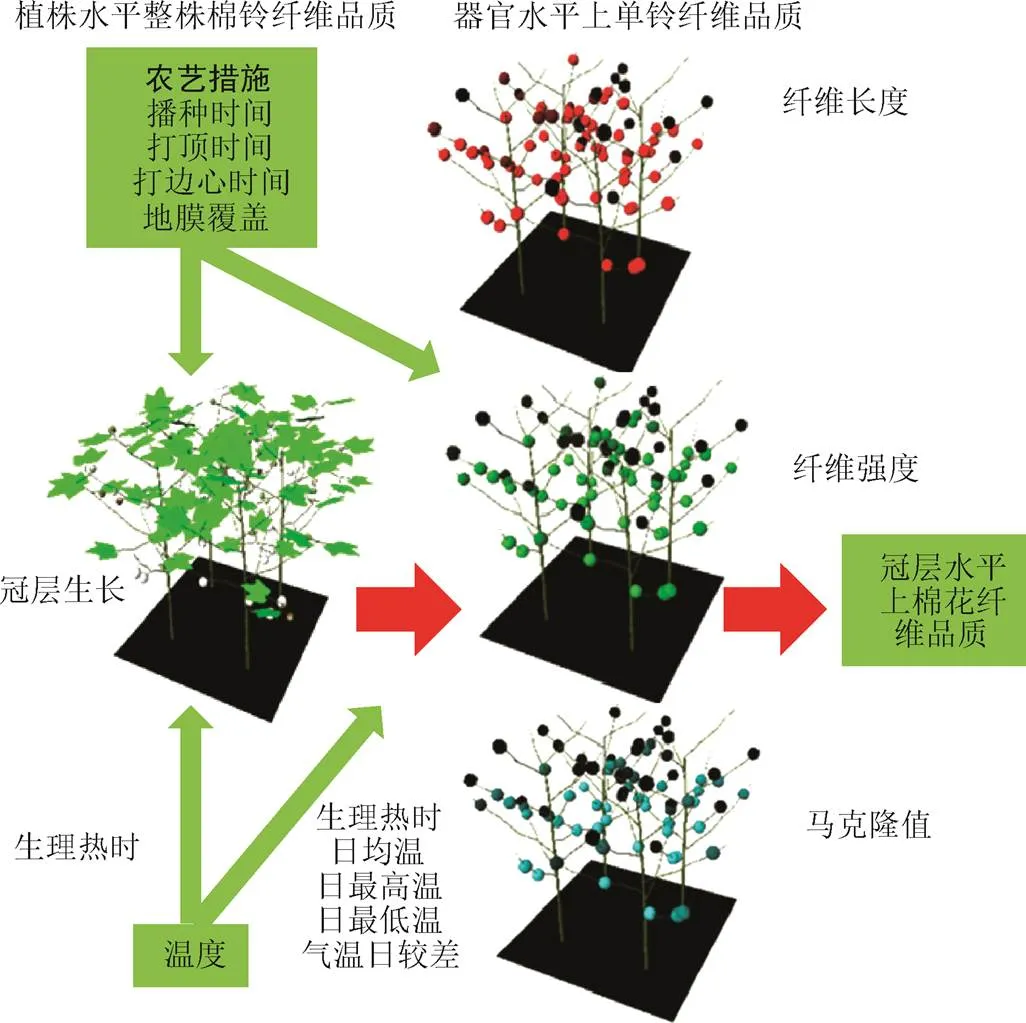
图1 CottonXL模型纤维品质模块图解
1.3 数据来源
本研究中气象数据包括乌兰乌苏2003年、莫索湾2004年和2007年、石河子1961-2018年地面气象观测资料,由新疆气象信息中心提供,模型模拟所需的土壤、管理措施和棉花品种信息由田间试验和大田调查获得。2003、2004、2007分期播种试验取棉花3、4果枝上的棉纤维进行品质检验,由农业部棉花品质监督检验测试中心完成品质检测。2006-2011年石河子地区棉花纤维样品的抽样调查数据由中国纤维检验局提供。纤维品质数据包括纤维长度、纤维比强度和马克隆值。
本研究采用均方根误差(root mean square error,RMSE)和标准均方根误差(normalized root mean square error,NRMSE)对实测值和模拟值的吻合程度进行统计分析。



1.4 低温冷害指标及典型冷害年的选取
延迟型冷害是低温对作物生长发育影响的累积效应,因此大多延迟型冷害以积温为指标,但受高温弥补效应的影响,积温不能够完全反映冷害程度。气温偏低程度和低温持续日数是判断冷害对作物生长影响程度的重要指标。因此本文基于前人研究成果[4-5,10],同时结合历史灾情资料,选取≥10 ℃积温距平、4~9月平均气温距平和4~9月低温最大持续日数3个因子,从致灾强度和指标数量2个方面定义灾害等级(表2):当3个指标同时满足某一致灾强度时,定义当年为该延迟型冷害等级;当3个指标满足不同致灾强度时,定义当年为冷害等级最小的指标所对应的冷害等级。并依此筛选出1961-2018年石河子地区典型棉花延迟型低温冷害年(表3)。经验证,根据该指标筛选出的典型冷害年包含所有严重气候减产年[32],与前人研究结果[4,32]一致。

表2 石河子地区棉花延迟型低温冷害指标

表3 1961-2018年石河子地区典型棉花延迟型低温冷害年
石河子地区棉花苗期、花铃期历年均值分别为4月中旬至6月上旬、7月上旬至9月上旬,计算历年4-9月各月月平均气温距平值,再分别将4-5月(春季苗期)、7-9月(夏秋季花铃期)平均气温距平值再平均,得到历年春季、夏秋季平均气温距平值(图2)。1972、1992春季为正距平、夏秋季为负距平,1975、1988春季为负距平、夏秋季为正距平,因此选择1972、1992为典型春季低温冷害年,选择1975、1988为典型夏秋季低温冷害年。
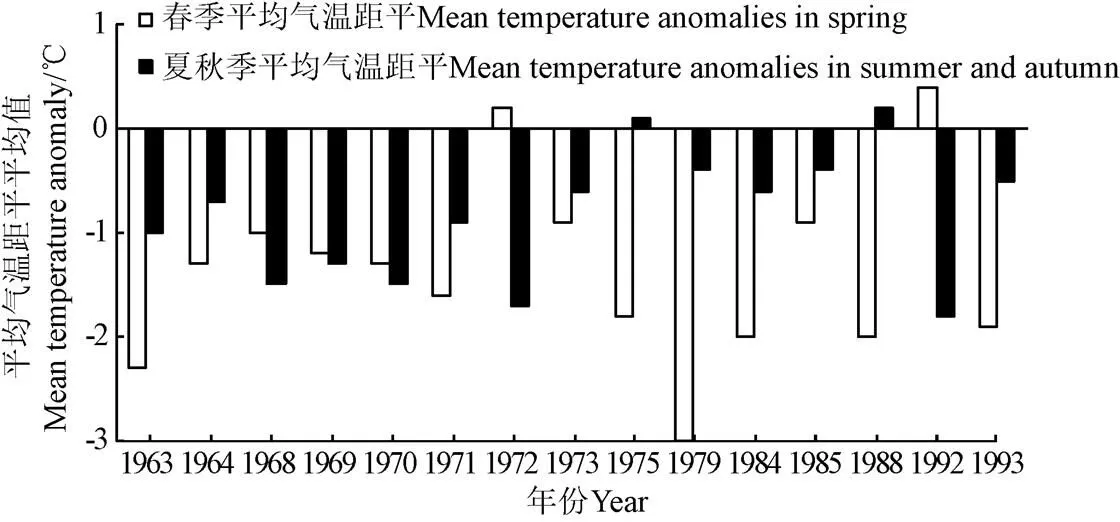
图2 1961-2018年石河子棉区延迟型冷害年春季、夏秋季平均气温距平值
2 结果与分析
2.1 模型参数调校与验证
为了检验模型在延迟型冷害下的适用性,本研究选取2003、2004和2007年分期播种试验4月10日、4月5日播种的品质数据对模型进行参数调校,选取其余播期品质数据对模型进行验证(表1)。由于分期播种试验品质数据为第3、4果枝上的棉纤维,因此在模型模拟结果中取第3、4果枝上的棉铃纤维品质平均值与实测值进行比较,验证模型模拟的准确性。依据试验方案模型中打顶时间、打边心时间、播种密度分别设置为7月15日、7月25日、20株/m2。由图3可知,棉花纤维长度、比强度和马克隆值观测值与模拟值间的RMSE分别为0.7 mm,0.9 cN/tex,0.1;NRMSE分别为2.6%,3.2%,3.0%。结果表明CottonXL模型对不同热量条件下棉花纤维品质的模拟结果与实际检验结果有很好的一致性,因此CottonXL能够较准确地模拟延迟型冷害对该地区棉花纤维品质的影响。
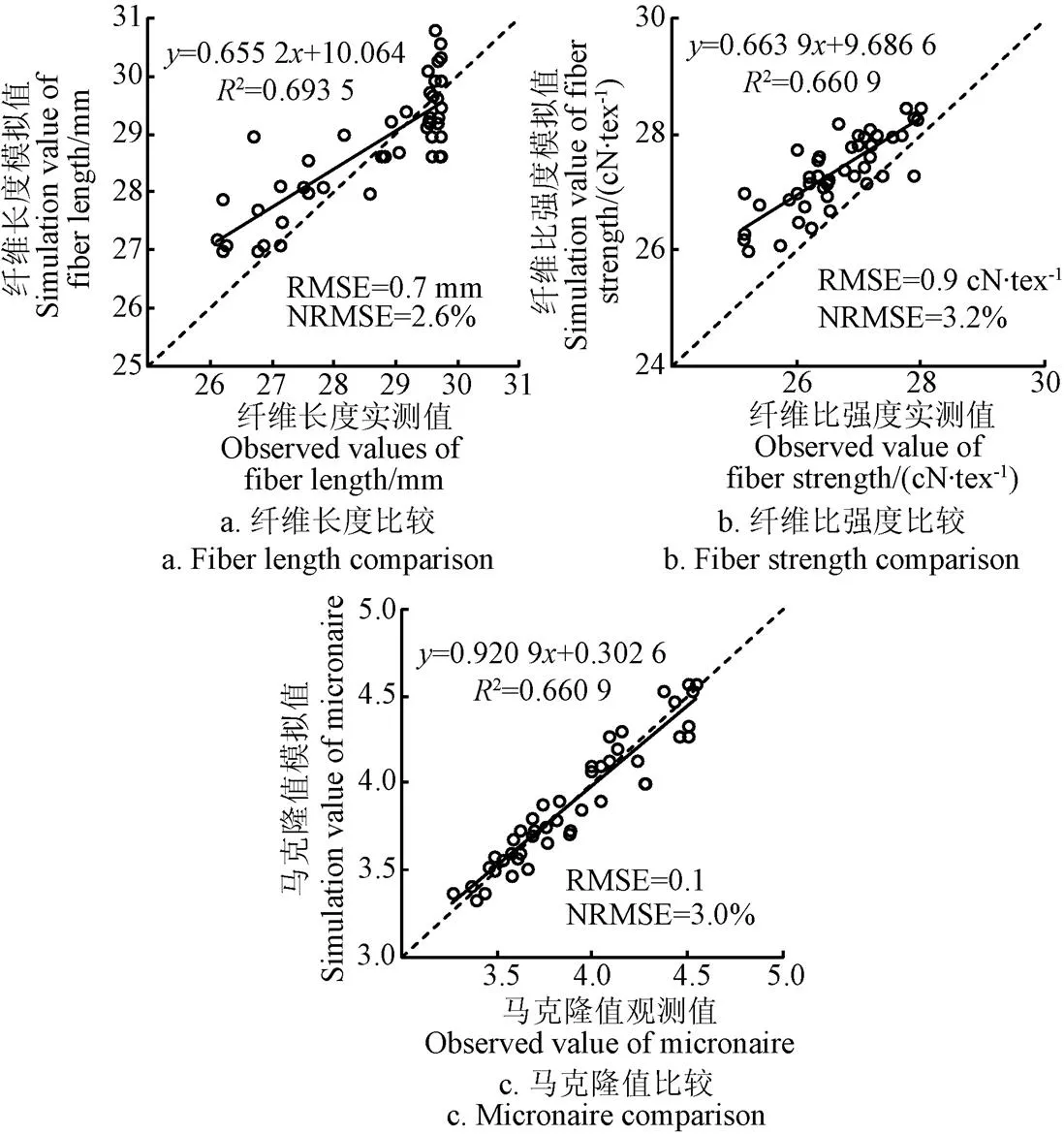
图3 分期播种试验棉花纤维品质观测值与模拟值的比较
为研究延迟型冷害对石河子地区棉花纤维品质整体状况的影响,利用2006-2011年石河子地区棉花纤维样品的抽样调查数据对模型模拟效果进行检验,由于抽样调查数据为区域纤维品质的平均状况,因此在模型模拟结果中取整株所有棉铃的纤维品质平均值与实测值比较,验证模型模拟的准确性。依据石河子地区棉花发育期历年均值将模型中播种时间、打顶时间、打边心时间、播种密度分别设置为4月20日、7月10日、7月25日、20株/m2。由图4可知,棉花纤维长度、比强度和马克隆值观测值与模拟值间的RMSE分别为0.4 mm,0.9 cN/tex,0.1;NRMSE分别为1.5%,3.1%,1.3%。结果表明CottonXL对石河子地区棉花纤维品质的模拟结果与实际检验结果有很好的一致性,因此CottonXL能够较准确的模拟该地区棉花纤维品质平均状况。2006-2011年均为无冷害年,以此6 a纤维长度、比强度和马克隆值模拟值的平均值(29.5 mm、27.1 cN/tex和3.82)作为下文分析中无冷害年纤维品质状况。
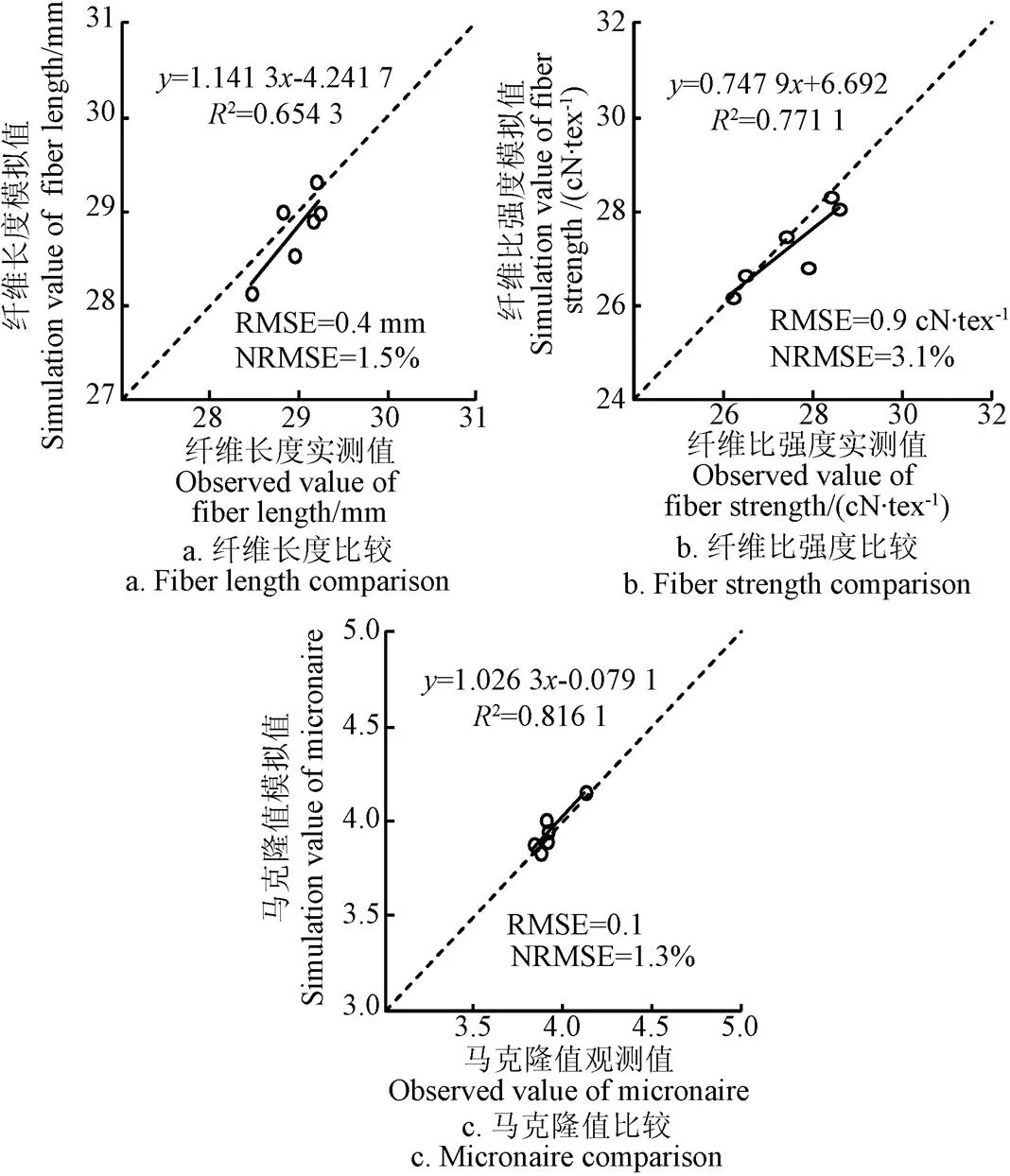
图4 石河子棉区棉花纤维品质观测值与模拟值的比较
2.2 延迟型低温冷害对棉花纤维长度的影响分析
从模拟结果来看(图5),随冷害程度的加重,棉花纤维长度显著降低(<0.01);冷害对高纤维长度(30~35 mm)棉铃的百分率有显著影响(<0.01),但不同冷害程度的影响差异性不显著。与无冷害年份相比,发生轻度、中度和重度延迟型冷害时纤维长度分别下降0.8、1.4和1.5 mm,即分别下降3%、5%和5%。发生冷害后纤维长度较长(30~35 mm)的棉铃数量显著减少(<0.01),纤维长度较短(25~30 mm)的棉铃数显著增加(<0.05)。

图5 不同等级延迟型低温冷害对纤维长度的影响
2.3 延迟型低温冷害对棉花纤维比强度的影响分析
从模拟结果来看(图6),随冷害程度的加重,棉花纤维比强度显著降低(<0.01);冷害对高纤维比强度棉铃的百分率有显著影响(<0.05)。与无冷害年份相比,发生轻度、中度和重度延迟型冷害时纤维比强度分别下降3.9、4.5和5.1 cN/tex,即分别下降14%、17%和19%。发生冷害后纤维比强度较大(30~35 cN/tex)的棉铃数量显著减少(<0.01),纤维比强度较小(20~25 cN/tex)的棉铃数增加最多。重度冷害发生时,纤维比强度最小(15~20 cN/tex)的棉铃数是轻度和中度冷害时的两倍。
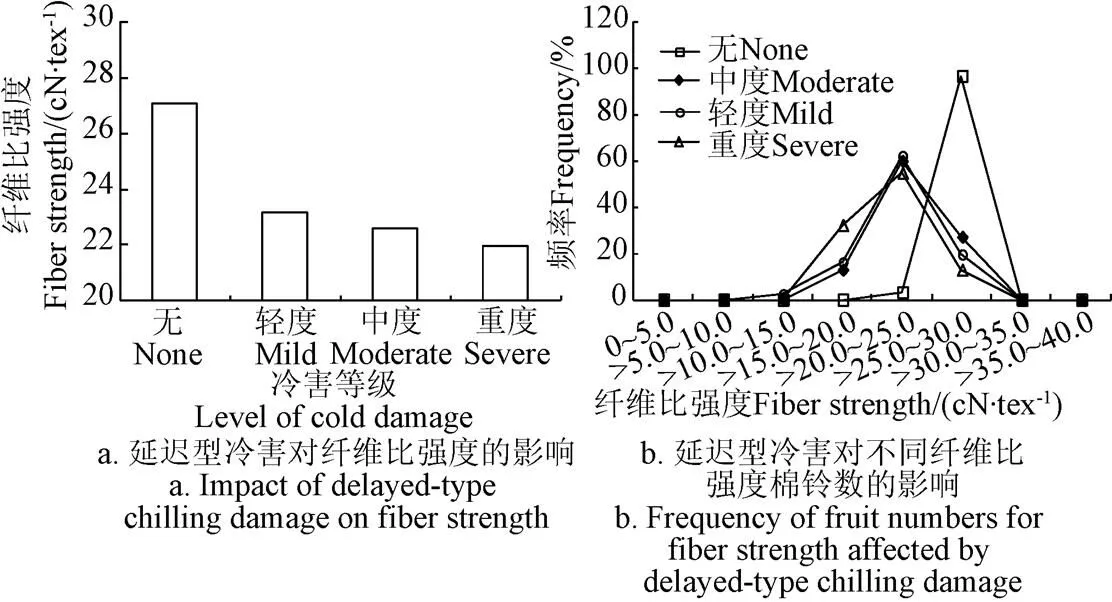
图6 不同等级延迟型低温冷害对纤维比强度的影响
2.4 延迟型低温冷害对棉花纤维马克隆值的影响分析
从模拟结果来看(图7),随冷害程度的加重,棉花纤维马克隆值显著降低(<0.01);冷害对马克隆值较高的棉铃百分率有显著影响(<0.05)。与无冷害年份相比,发生轻度、中度和重度延迟型冷害时马克隆值分别下降1.0、1.2和1.4,即分别下降27%、32%和36%。发生冷害后马克隆值较高(3.75~4.5)的棉铃数量显著减少(<0.01),轻度冷害时,马克隆值为2.25~3.75的棉铃数占棉铃总数的70%。中度和重度冷害时,马克隆值为1.5~2.25的棉铃占比最多,且发生重度冷害时所有棉铃马克隆值均低于3.75。
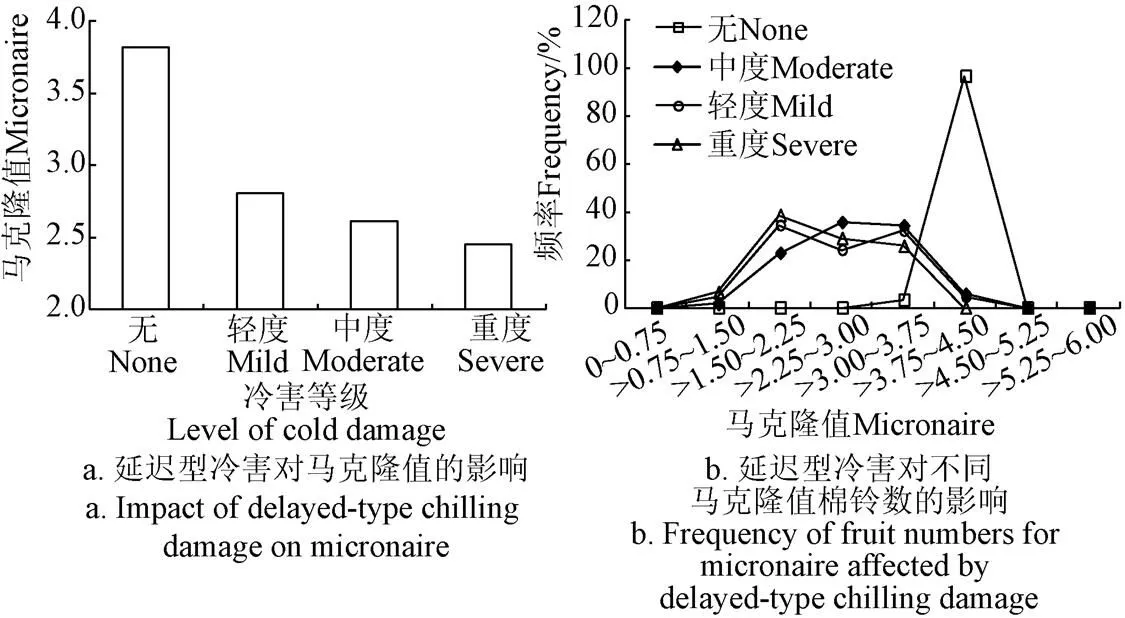
图7 不同等级延迟型低温冷害对马克隆值的影响
2.5 不同时段延迟型低温冷害对棉花纤维品质的影响
从模拟结果来看(图8),同为轻度低温冷害,夏秋季型低温冷害情况下,纤维长度、纤维比强度和马克隆值分别比春季型低温冷害情况下下降1.2 mm、2.8 cN/tex、0.7;同为中度低温冷害,夏秋季型低温冷害情况下,纤维长度、纤维比强度和马克隆值分别比春季型低温冷害情况下下降1.6 mm、2.6 cN/tex、0.6。同时可以看出,轻度夏秋季型低温冷害情况下,纤维长度、纤维比强度和马克隆值比中度春季型低温冷害情况下分别偏低0.7 mm、1.5 cN/tex、0.4。
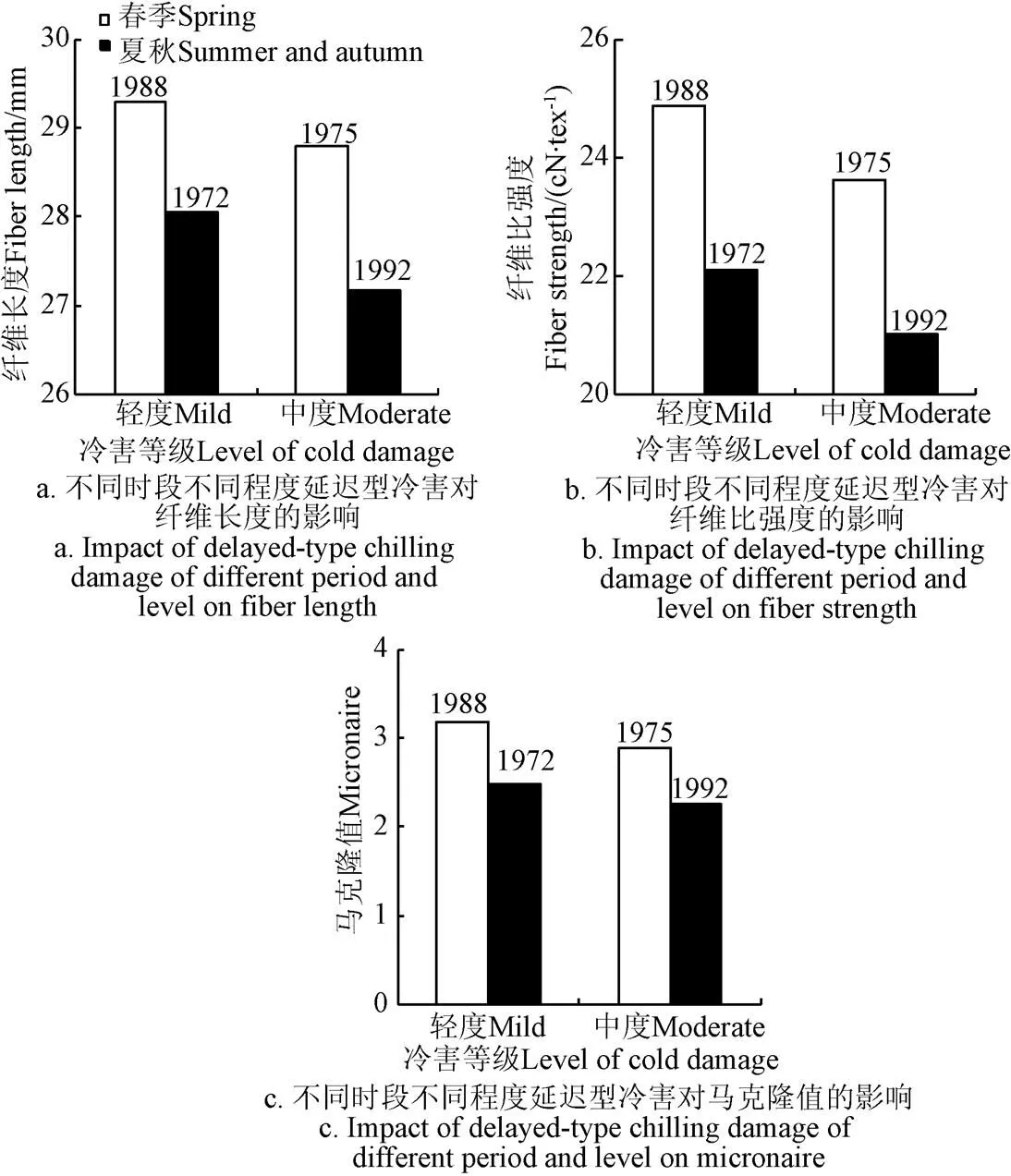
图8 不同时段延迟型低温冷害对棉花纤维品质的影响
3 讨 论
棉花具有无限生长的习性,生长发育过程中不断开花结铃,遇非致命灾害具有可恢复性。生长前期发生低温时,若后期热量持续偏少,则形成延迟型冷害,使得棉铃不能完全成熟,造成产量和品质降低;若后期热量充足,作物生长发育进程加快,可弥补前期热量不足对棉花生长发育造成的影响,降低延迟型冷害等级。当生长后期发生低温时,棉铃吐絮延迟,部分成铃较晚的棉铃不能够完全成熟,使得霜前花减少,产量和品质均降低。因此生长后期低温冷害较生长前期低温冷害影响更大。分期播种试验,因播种时间不同,造成棉花生长过程中气象条件存在差异。本文以2地3 a每年5个播期的试验数据(即15个热量年型)验证模型,说明模型能够准确模拟不同热量条件下棉花纤维品质状况,即模型可以模拟延迟型冷害对纤维品质的影响。从模拟结果来看,当发生延迟型冷害时,外围铃(即成铃时间较晚的棉铃)的纤维品质显著降低(<0.01),从而影响了纤维品质整体水平和收益。因此,在延迟型冷害较严重的年份,建议分批采收以保证获得一定数量的优质纤维,从而降低损失。新疆棉区光照充足且灌溉植棉,热量条件的稳定性是该地区棉花优质高产最大的限制因素。前人以减产率为评价指标,从全年累计积温、气温距平等方面确定延迟型冷害指标,反映的是全年热量条件水平,对阶段性低温表征性不强,本文结合前人研究成果得出综合性的棉花延迟型冷害指标,并根据低温程度和持续时间划分出不同冷害年型,定量评估不同时段不同程度延迟型冷害对纤维品质的影响。
此外,棉花纤维品质是遗传因素和环境因素相互作用的结果,在不同的环境条件下(例如温度、光照、降水等),同一品种的棉花纤维品质并不相同。温度是决定棉花纤维品质的最主要的因子,干旱和土壤氮素供应不足也会导致棉花纤维品质降低。本研究不考虑品种因素,模拟参数设定水分及氮素供应充足,单从热量方面分析气象条件对纤维品质的影响。对标具体品种时,纤维品质因冷害影响而下降的量值会有差异,但不同程度、不同时期延迟型冷害对纤维品质影响的基本观点具有普适性。
4 结 论
本文利用作物模型模拟的方法分析了不同程度、不同时段延迟型低温冷害对棉花纤维品质的影响。结果表明CottonXL模型能够较准确地模拟延迟型冷害对棉花纤维品质的影响,不同热量条件下纤维长度、纤维比强度、马克隆值模拟结果与实测值间的RMSE分别为0.7 mm、0.9 cN/tex、0.1。与无冷害年份相比,发生轻度、中度、重度冷害时,纤维长度分别下降3%、5%和5%,纤维比强度分别下降14%、17%和19%,马克隆值分别下降27%、32%和36%,因此冷害对棉花纤维马克隆值影响最大、纤维比强度次之,对纤维长度影响最小。随冷害程度的加重纤维长度较长、纤维比强度较大且马克隆值适中的棉铃数量显著减少(<0.01),纤维品质整体下降。发生轻度、中度和重度冷害时,纤维长度分别下降0.8、1.4和1.5 mm,纤维比强度分别降低3.9、4.5和5.1 cN/tex,马克隆值分别降低1.0、1.2和1.4。同等程度延迟型低温冷害情况下,夏秋季低温冷害对纤维品质的影响大于春季低温冷害。轻度夏秋季型低温冷害对纤维品质的影响较中度春季型低温冷害更大。
[1] 熊宗伟,顾生浩,毛丽丽,等. 中国棉花纤维品质和气候因子的空间分布特征[J]. 应用生态学报,2012,23(12):3385-3392.
Xiong Zongwei, Gu Shenghao, Mao Lili, et al. Spatial distribution characteristics of China cotton fiber quality and climatic factors based on GIS[J]. Chinese Journal of Applied Ecology, 2012, 23(12): 3385-3392. (in Chinese with English abstract)
[2] 中国统计年鉴[M]. 北京:中国统计出版社,2018.
[3] 李新建,毛炜峄,谭艳梅. 新疆棉花延迟型冷害的热量指数评估意义[J]. 中国农业科学,2005,38(10):1989-1995.
Li Xinjian, Mao Weiyi, Tan Yanmei. Assessment of cotton delayed cool injury by heat index and significance in Xinjiang[J]. Scientia Agricultura Sinica, 2005, 38(10): 1989-1995. (in Chinese with English abstract)
[4] 李新建,唐凤兰,杨举芳,等. 新疆棉花延迟型冷害指标试验研究[J]. 沙漠与绿洲气象,2007,1(2):44-46.
Li Xinjian, Tang Fenglan, Yang Jufang, et al. Experiment study on cotton delayed cool injury index in Xinjiang[J]. Desert and Oasis Meteorology, 2007, 1(2): 44-46. (in Chinese with English abstract)
[5] 邹陈,陈冬花,吉春容,等. 石河子棉区棉花阶段延迟型冷害指标研究[J]. 沙漠与绿洲气象,2012,6(5):46-50.
Zou Chen, Chen Donghua, Ji Chunrong, et al. The research of cotton delayed cool injury index in the cotton region of Shihezi[J]. Desert and Oasis Meteorology, 2012, 6(5): 46-50. (in Chinese with English abstract)
[6] 陈超,潘学标,李慧阳,等. 基于COSIM模型的新疆棉花延迟型冷害指标分析[J]. 棉花学报,2009,21(3):201-205.
Chen Chao, Pan Xuebiao, Li Huiyang, et al. Analysis of cotton delayed cool injury indices in Xinjiang based on COSIM[J]. Cotton Science, 2009, 21(3): 201-205. (in Chinese with English abstract)
[7] 王雪姣,潘学标,陈超,等. 基于COSIM模型的棉花冷害预测研究[J]. 棉花学报,2012,24(1):52-61.
Wang Xuejiao, Pan Xuebiao, Chen Chao, et al. Forecasting cotton chilling damage based on COSIM[J]. Cotton Science, 2012, 24(1): 52-61. (in Chinese with English abstract)
[8] 林海荣,李章成,周清波,等. 基于ETM植被指数和冠层温度差异遥感监测棉花冷害[J]. 棉花学报,2009,21(4):284-289.
Lin Hairong, Li Zhangcheng, Zhou Qingbo, et al. Monitoring frost disaster of cotton based on difference of vegetation index and canopy temperature by remote sensing[J]. Cotton Science, 2009, 21(4): 284-289. (in Chinese with English abstract)
[9] 李新建,毛炜峄,杨举芳,等. 以热量指数表示北疆棉区棉花延迟型冷害指标的研究[J]. 棉花学报,2005,17(2):88-93.
Li Xinjian, Mao Weiyi, Yang Jufang, et al. Characterization of growth delayed cotton cool damage by heat index in the Northern Xinjiang[J]. Cotton Science, 2005, 17(2): 88-93. (in Chinese with English abstract)
[10] 傅玮东,李新建,姚艳丽. 新疆棉花生长中期低温冷害指标的初步研究[J]. 干旱区研究,2007,24(4):495-498.
Fu Weidong, Li Xinjian, Yao Yanli. Study on the indexes of low temperature and chilling injury in the metaphase of cotton growth in the main cotton growing regions in Xinjiang[J]. Arid Zone Research, 2007, 24(4): 495-498. (in Chinese with English abstract)
[11] 郑维,郑之龙,唐凤兰. 北疆棉花纤维生长期冷害指标研究[J]. 新疆气象,1990,13(2):22-25.
Zheng Wei, Zheng Zhilong, Tang Fenglan. Study on cotton cool injury index during fiber growth period in the North of Xinjiang[J]. Xinjiang Meteorology, 1990, 13(2): 22-25. (in Chinese with English abstract)
[12] 韩忠玲,崔玉莹,陈乐,等. 新疆棉花低温冷害动态监测研究[J]. 安徽农业科学,2019,47(2):205-214.
Han Zhongling, Cui Yuying, Chen Le, et al. Dynamic monitoring of cotton cold damage in Xinjiang[J]. Anhui Agriculture Science, 2019, 47(2): 205-214. (in Chinese with English abstract)
[13] Richard G P, Roy G C, Jinfa Z. Genetic variation for agronomic and fiber properties in an introgressed recombinant inbred population of cotton[J]. Crop Science, 2006, 46(3): 1311-1317.
[14] Pettigrew W T, Adamczyk J. Nitrogen fertility and planting date effects on lint yield and Cry1Ac (Bt) endotoxin production[J]. Agronomy Journal, 2006, 98(3): 691-697.
[15] Read J J, Reddy K R, Jenkins J N. Yield and fiber quality of upland cotton as influenced by nitrogen and potassium nutrition[J]. European Journal of Agronomy, 2006, 24(3): 282-290.
[16] Girma K, Teal R K, Freeman K W, et al. Cotton lint yield and quality as affected by applications of N, P, and K fertilizers[J]. Journal of Cotton Science, 2007, 11(1): 12-19.
[17] Pettigrew W T. Environmental effects on cotton fiber carbohydrate concentration and quality[J]. Crop Science, 2001, 41(4): 1108-1113.
[18] Zhao D, Oosterhuis D M. Cotton responses to shade at different growth stages: growth, lint yield and fiber quality[J]. Experimental Agriculture, 2000, 36(1): 27-39.
[19] Yeates S J, Constable G A, McCumstie T. Irrigated cotton in the tropical dry season. Ⅲ: Impact of temperature, cultivar and sowing date on fiber quality[J]. Field Crops Research, 2010, 116(3): 300-307.
[20] 王雪姣. 气候变化对新疆棉花物候、产量和品质的影响与适应措施[D]. 北京:中国农业大学,2015.
Wang Xuejiao. Impact and Adaptation of Climate Change on Cotton Phenology, Yield and Fiber Quality in Xinjiang[D]. Beijing: China Agricultural University, 2015. (in Chinese with English abstract)
[21] 熊宗伟,王雪姣,顾生浩,等. 中国主产棉区气象因子和纤维品质的相关性研究[J]. 棉花学报,2014,26(2):95-104.
Xiong Zongwei, Wang Xuejiao, Gu Shenghao, et al. Correlation between meteorological factors and cotton fiber quality in major cotton-producing regions of China[J]. Cotton Science, 2014, 26(2): 95-104. (in Chinese with English abstract)
[22] Gipson J R, Ray L L. Fiber elongation rates in five varieties of cotton (L.) as influenced by night temperature[J]. Crop Science, 1969, 9(3): 339-341.
[23] 张丽娟,薛晓萍,张冬有,等.低温对棉花纤维品质影响模型的研究[J]. 自然灾害学报,2006,15(3):52-57.
Zhang Lijuan, Xue Xiaoping, Zhang Dongyou, et al. Model of low temperature influence on cotton fiber quality[J]. Journal of Natural Disasters, 2006, 15(3): 52-57. (in Chinese with English abstract)
[24] Zhao W, Zhou Z, Meng Y, et al. Modeling fiber fineness, maturity, and micronaire in cotton (L.)[J]. Journal of Integrative Agriculture, 2013, 12(1): 67-79.
[25] Constable G A, Harris N V, Paull R E. The effect of planting date on the yield and some fibre properties of cotton in the Namoi Valley[J]. Australian Journal of Experimental Agriculture and Animal Husbandry, 1976, 16(79): 265-271.
[26] Bange M P, Milroy S P. Growth and dry matter partitioning of diverse cotton genotypes[J]. Field Crops Research, 2004, 87(1): 73-87.
[27] Gu S H, Evers J B, Zhang L, et al. Modelling the structural response of cotton plants to mepiquat chloride and population density[J]. Annals of Botany, 2014, 14(4): 877-887.
[28] Zhang L, Van Der Werf W, Cao W, et al. Development and validation of SUCROS-Cotton: A potential crop growth simulation model for cotton[J]. NJAS-Wageningen Journal of Life Sciences, 2008, 56(1/2): 59-83.
[29] Vos J, Evers J B, Buck-Sorlin G H, et al. Functional-structural plant modelling: A new versatile tool in crop science[J]. Journal of Experimental Botany, 2010, 61(8): 2101-2115.
[30] 顾生浩. 棉花功能结构模型建立与新疆棉花产量预测[D]. 北京:中国农业大学,2018.
Gu Shenghao. A Functional-structural Model of Cotton and Prediction of Cotton Yield in Xinjiang[D]. Beijing: China Agricultural University, 2018. (in Chinese with English abstract)
[31] Wang X J, Zhang L, Evers J B, et al. Predicting the effects of environment and management on cotton fibre growth and quality: A functional-structural plant modeling approach[J]. AoB Plants, 2014, 1(1): 1-16.
[32] 李新建,何清,袁玉江. 新疆棉花严重气候减产年的热量特征分析[J]. 新疆农业大学学报,2000,23(4):20-26.
Li Xinjian, He Qing, Yuan Yujiang. Character analysis of amount of heat in serious reduction year of cotton climatic output in Xinjiang[J]. Journal of Xinjiang Agricultural University, 2000, 23(4): 20-26. (in Chinese with English abstract)
Impact of delayed-type chilling damage on cotton fiber quality based on CottonXL
Wang Sen1,2, Wang Xuejiao1,2※, Ji Chunrong2, Jiang Yuanan2, Yang Mingfeng3, Ji Fen3
(1.,830002,; 2.,830002,; 3.,832000,)
Cotton (Gossypium hirsutum) fiber quality is the key factor that determines the price of cotton and its textiles. Fiber length, strength, strength and micronaire are the main indicators of cotton fiber quality. Temperature is the most important meteorological factor that determines the fiber quality. Delayed-type chilling damage is the main meteorological disaster in cotton production in Xinjiang. And it is also the meteorological disaster that has the greatest impact on fiber quality. Quantitative evaluation of the effect of chilling damage on cotton fiber quality is of great significance for disaster assessment and formulating countermeasures. Functional-structural model of cotton (CottonXL) is a visual model that developed on GroIMP platform. It can vividly simulate the three-dimensional growth process and spatial distribution of fiber quality of cotton under different scenarios. So, the model is a powerful tool for studying the effect of climate on fiber quality. In this study, the parameters of the model were calibrated and validated by the experimental data of staged sowing. Because the quality data of stage sowing experiment were the cotton fiber on fruit branches 3 and 4, the simulated value of fiber quality of bolls on fruit braches 3 and 4 were averaged to compared with the observed data. The root mean square error (RMSE) and normalized root mean square error (NRMSE) of observed and simulated fiber length, strength and micronaire were 0.7 mm, 0.9 cN/tex, 0.1 and 2.6%, 3.2%, 3.0%, respectively. The results showed that CottonXL can accurately simulate the effects of different heat conditions on fiber quality. In order to study the effect of delayed chilling injury on cotton fiber quality in Shihezi area, the model were validated by the sample survey data of cotton fiber quality in Shihezi area from 2006 to 2011. Because the sampled data were the average value of Shihezi area, the simulated value of fiber quality of all cotton bolls in the whole plant were averaged to compared with sampled data. The RMSE and NRMSE of observed and simulated fiber length, strength and micronaire were 0.4 mm, 0.9 cN/tex, 0.1 and 1.5%, 3.1%, 1.3%, respectively. The results showed that CottonXL can accurately simulate the average value of fiber quality in Shihezi area. The typical years of delayed-type chilling damage in different degrees were selected from 1961 to 2017 by using the index of delayed chilling damage and disaster data. Based on calibration and validation of functional-structural plant model CottonXL, we simulated the effects of different degrees of chilling damage on fiber quality. The results showed chilling damage had the greatest effect on micronaire, followed by fiber strength, and had the least effect on fiber length. With the aggravation of chilling damage, the number of cotton bolls with longer fiber length, lager fiber strength and moderate micronaire decreased significantly, and the fiber quality decreased as a whole. The fiber length, strength and micronaire decreased by 0.8, 1.4 and 1.5 mm, 3.9, 4.5 and 5.1 cN/tex, 1.0, 1.2 and 1.4, respectively when mild, moderate and severe chilling damage occurred. Under the same degree of delayed chilling damage, the effect of chilling damage in summer and autumn on fiber quality was greater than that in spring. Under condition with insufficient heat, changing sowing time, cut top time and planting density could reduce losses.
crops; models; fibers; chilling damage; fiber length; fiber strength; micronaire
王 森,王雪姣,吉春容,江远安,杨明凤,季 芬. CottonXL模型模拟研究延迟型低温冷害对棉花纤维品质的影响[J]. 农业工程学报,2019,35(20):171-177.doi:10.11975/j.issn.1002-6819.2019.20.021 http://www.tcsae.org
Wang Sen, Wang Xuejiao, Ji Chunrong, Jiang Yuanan, Yang Mingfeng, Ji Fen. Impact of delayed-type chilling damage on cotton fiber quality based on CottonXL[J]. Transactions of the Chinese Society of Agricultural Engineering (Transactions of the CSAE), 2019, 35(20): 171-177. (in Chinese with English abstract) doi:10.11975/j.issn.1002-6819.2019.20.021 http://www.tcsae.org
2019-06-15
2019-09-28
中国沙漠气象科学研究基金(Sqj2016013);新疆气象局科学技术研究与应用技术开发项目(MS201707);中亚大气科学研究基金(CAAS201817);新疆维吾尔自治区自然科学基金(2019D01B48)
王 森,工程师,主要从事农业气象灾害及风险区划研究。Email:wang_sen90@126.com
王雪姣,高级工程师,主要从事作物模型和农业气象灾害研究。Email:wxjby@126.com
10.11975/j.issn.1002-6819.2019.20.021
S165+.27
A
1002-6819(2019)-20-0171-07
